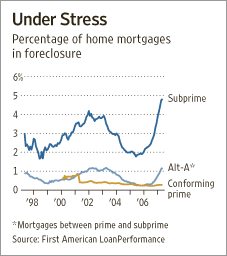From the Wall Street Journal:
States Aim to Stem Tide
Of Home Foreclosures
With Funds for Refinancing
By THADDEUS HERRICK
July 23, 2007; Page A2
Hoping to slow the quickening pace of home foreclosures, about a half-dozen states are setting up funds to help homeowners with high-risk subprime mortgages refinance to more-affordable loans.
The states — which include Maryland, Massachusetts, New Jersey, New York, Ohio and Pennsylvania — are expected to invest a total of more than $500 million in the effort. That isn’t much, given the size of the problem, but state officials hope it will be enough to keep some vulnerable low- and moderate-income neighborhoods from sliding into decline.
Some of the programs will be similar to existing government-lending programs, in which the state extends mortgages to homeowners and then sells those home loans, in some cases to companies such as government-sponsored mortgage-finance giants Fannie Mae and Freddie Mac. The state then recycles the proceeds from the sales to make additional loans.
…
More than one million American homes are expected to enter foreclosure this year; the total represents about 2.3% of the nation’s 44 million home loans, according to Freddie Mac, which bases its estimate on data provided by Mortgage Bankers Association, a Washington-based trade group. Freddie Mac says about 60% of those homes carry subprime mortgages. Subprime mortgages are home loans made to borrowers with shaky credit records.The projected foreclosure rate — higher than during the oil bust of 1987 but not as high as in the 2002 recession — poses a significant threat to the housing sector, and possibly to the nation’s economy if it spurs consumers to maintain a tight grip on their wallets. “Falling home prices hurt consumer spending,” says Patrick Newport, an economist at consulting firm Global Insight.
…
For example, a borrower who took out a $300,000 ARM at 7.32% in mid-2005 would have had an initial monthly payment of $2,060.79. A typical adjustment would have pushed that payment to $2,692.63 this year, says Keith Gumbinger, vice president of HSH Associates, a New Jersey publisher of mortgage-rate data. Unable to cover the higher payments, a number of homeowners have fallen behind.The trend can put neighborhoods at risk. Houses left vacant as the result of foreclosures tend to push property values down and cause neighbors that can afford to do so to sell out and move away, creating a snowball effect.
…
“No one is saying this will solve the problem,” says Nicolas Retsinas, director of the Joint Center for Housing Studies at Harvard University. “But it could make a difference.”


let me get this straight. the taxpayers
will have to bail these a–holes out that
took on bad paper.
NJ, a true Welfare State
The projected foreclosure rate — higher than during the oil bust of 1987 but not as high as in the 2002 recession
How could one project that the foreclosure rate will be less than in 2002? Despite a recession at the time, home prices were appreciating briskly, however homes were still relatively affordable (by today’s standards). Money was relatively cheap & easy as a result of the Fed’s attempt to stimulate the economy. Lending standards had started to loosen, but nothing like the circus we saw in 2005/2006.
Fast forward to 2007, ARMs are resetting, prices are stagnant or falling, lending standards are tightening and foreclosures are rising. People have gotten into loans for way too much money, where they have no hope of paying the real payment and little hope of refinancing. Despite the relatively strong economy with low unemployment, foreclosures are on the rise….something never seen outside of a recession …if we see a recession on the horizon, look out below.